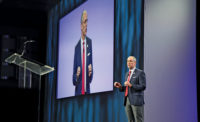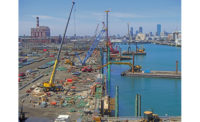In what one official termed "our big experiment," the Obama administration convened an unusual four-hour closed session at the White House on March 9 for top industry and federal managers to figure out how to push sustainability into federal infrastructure procurement.
Despite the administration's 2009 executive order directing agencies to use more clean energy and cut greenhouse gases, key issues loom on how to integrate long-term sustainability into project bidding, design and construction. Cost impacts remain a key concern.
"We either learn to make infrastructure sustainable or we're toast," said Paul J. Zofnass, president of EFCG Inc., an industry financial consultant and sustainability proponent who helped engineer the meeting for about 80 attendees from design firms, industry groups, and federal and military agencies. Government attendees were from the defense, transportation, housing and urban development departments, the General Services Administration and the Office of Management and Budget.
Measuring Life-Cycle Costs
The meeting was sponsored by the White House Council on Environmental Quality and the Zofnass Program for Sustainable Infrastructure. The program, industry-funded at Harvard University, has developed an infrastructure sustainability rating and measuring system called "Envision." Similar to LEED for buildings, it has a multi-tiered credit-award approach based on impacts in areas such as community, resource-use and life-cycle costs.
The program linked last year with the Washington-based Institute for Sustainable Infrastructure (ISI), which created its own rating system through the American Society of Civil Engineers, the American Council of Engineering Companies and the American Public Works Association.
In a related development, the American Water Works Association (AWWA) announced March 19 that it is linking with ISI to develop a sustainability rating system specifically for underground water infrastructure, based on what the trade group says is "cost objectives, environmental evaluations and outcome-based objectives." Denver-based AWWA says it has 50,000 members, including 4,700 U.S. utilities.
Industry participants at the White House event generally applauded the federal outreach, but one attendee, who declined to be identified as one critical of clients, said, "There was mixed energy in the room, with about half wanting to move forward aggressively and the other seeing this effort was too hard."
Another noted a dearth of contractor representatives and no participation from one key federal infrastructure builder, the Dept. of Homeland Security. He noted "lack of engagement" among some government attendees and concerns that short-term capital costs govern infrastructure procurement decisions. "We need sustainability formulas for the long term and accountability," he said, also noting challenges in developing uniform ratings for diverse infrastructure projects and in measuring broader societal impacts.
In anonymous comments submitted before the meeting, participants noted other sustainability barriers: the government's annual budgeting cycle, no enabling language in the Federal Acquisition Regulation (FAR), an inability to "monetize" sustainability in costing approaches, a perceived lack of competitive advantage, an aversion to risk and an emphasis on low-cost vs. best-value bidding.
"Should we add 'depletion' costs for non-renewable resources consumed during construction projects and use that as part of a sustainability scorecard?" said Michael W. Creed, CEO of McKim & Creed.
"Procurement practice is a stumbling block," said Wendi Goldsmith, CEO of BioEngineering Group, a Salem, Mass., consultant. "Current habits and regulations hamper sustainable infrastructure decisions, though a few successes and trends illustrate how and why to improve the situation." She said that "despite the confining elements of the FAR, many workable options for sustainable project procurement exist, and should be expanded."
Goldsmith said that performance based RFPs and Public-Private Partnerships should be used more extensively "so operations can be improved and budgets can be transcended."
She added that "not only should RFPs be structured with clear sustainability objectives, but that selection procedures should be improved to clearly promote selection of qualified proposers, rather than punishing creative and broad responses, as has been observed."
Zofnass noted that there will be "follow-up meetings with the different groups" set up in the next few months. He said federal participants "are sincerely committed to increasing the sustainability components of their projects, and are looking for the best way to accomplish this."
One participant noted that "Zofnass and ISI can be a force for success if they keep up some pressure." Said another, "If the administration wants to drive sustainable design into both the government portfolio and the private sector, don't tout one or two high-profile success stories. Make this a way of doing business, embedded and expected, not just an approach that's a good occasional sound bite or useful when convenient."
Envision developers say they will release this year a "pre-planning checklist" for assessing project sustainability as well as an "economic assessment tool to help owners determine the sustainable return on their investment."
Story was updated to reflect related announcement on water infrastructure.





